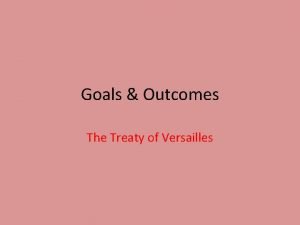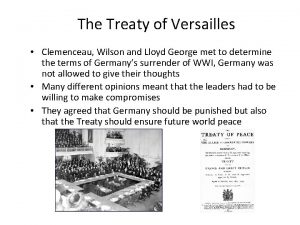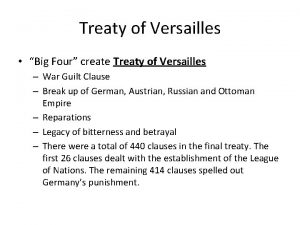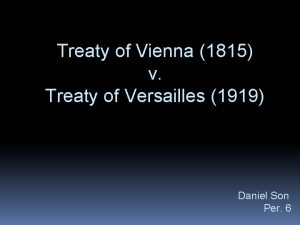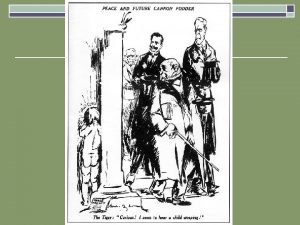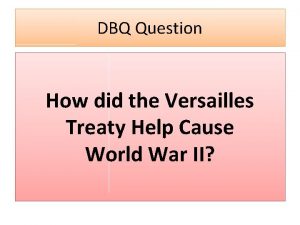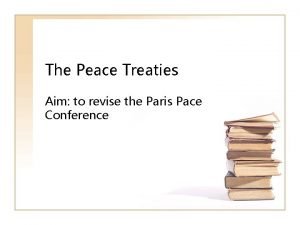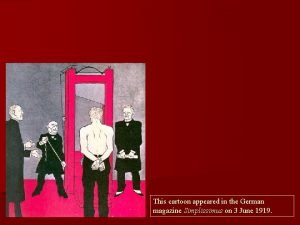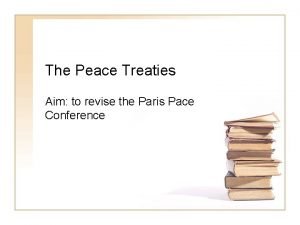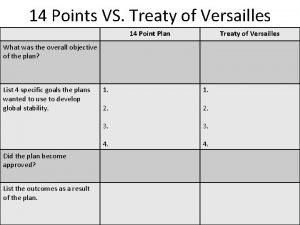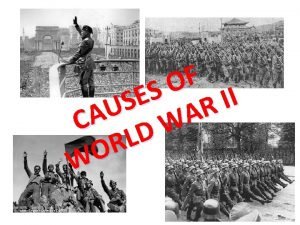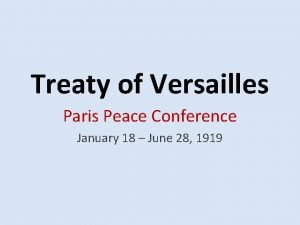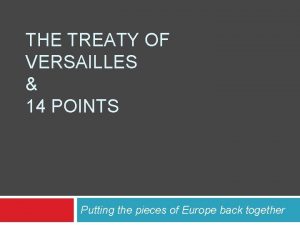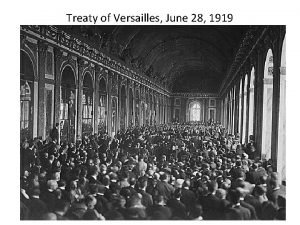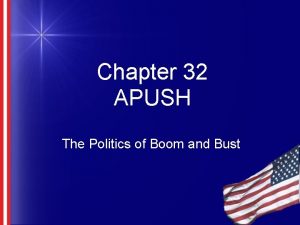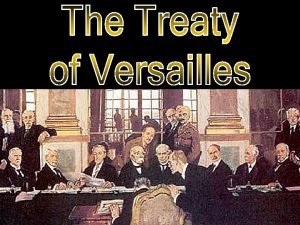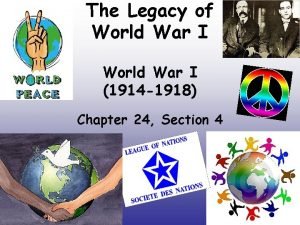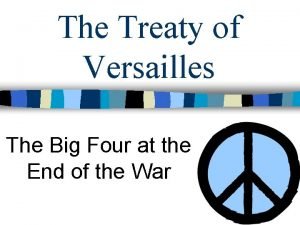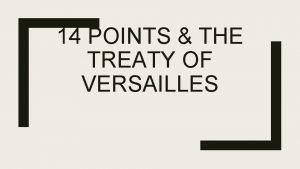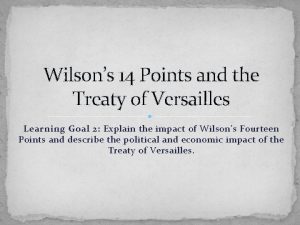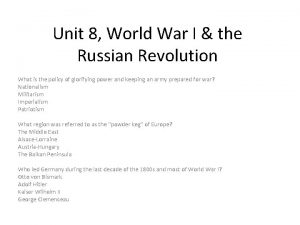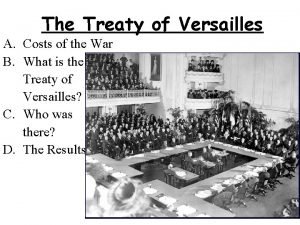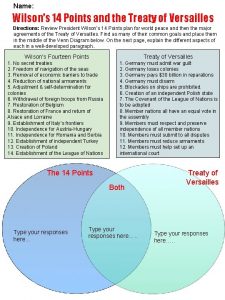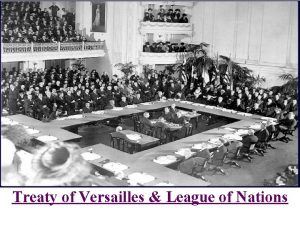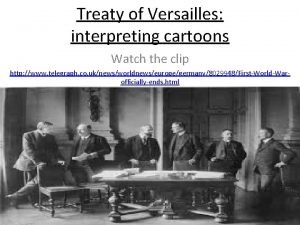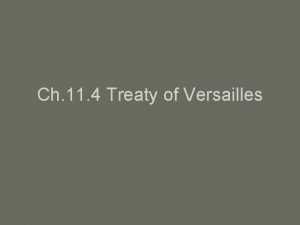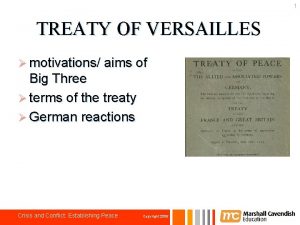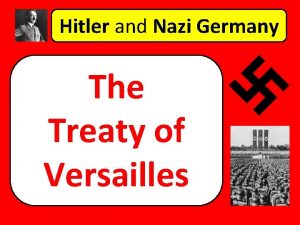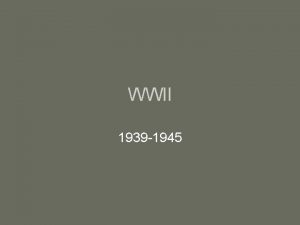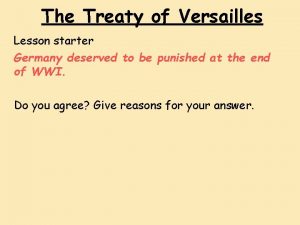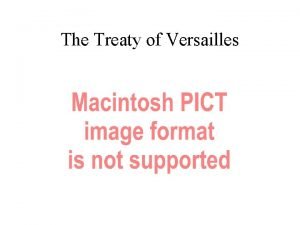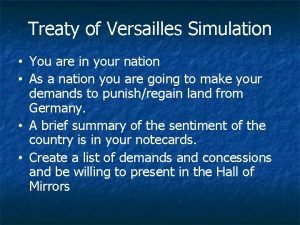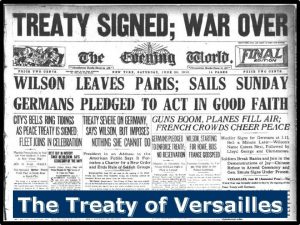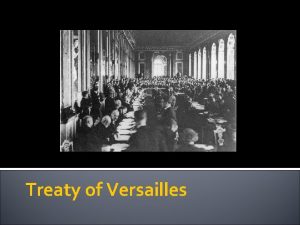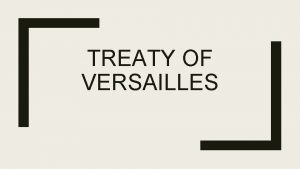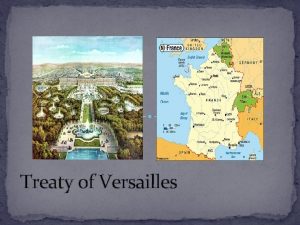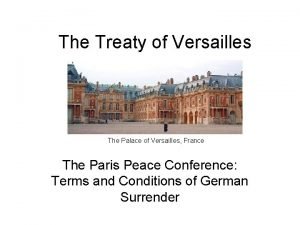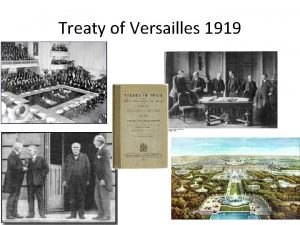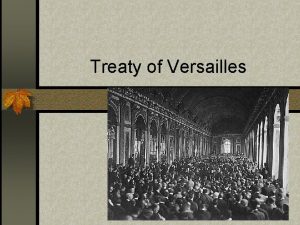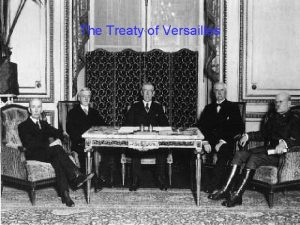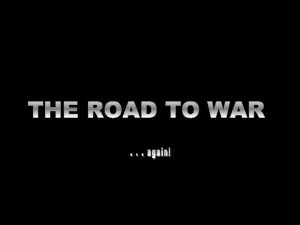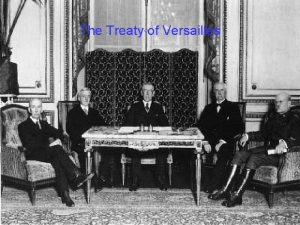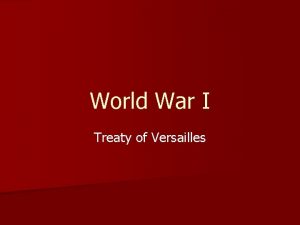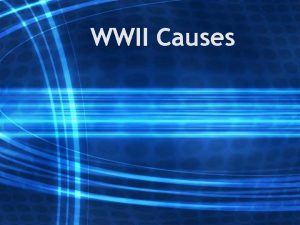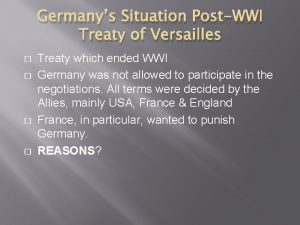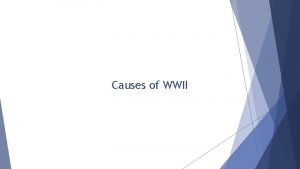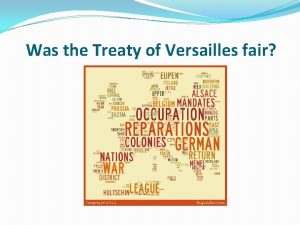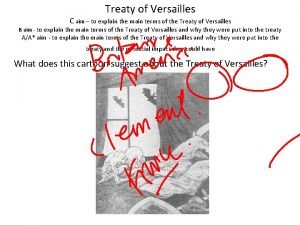Aim Was the Treaty of Versailles a fair





































- Slides: 37

Aim: Was the Treaty of Versailles a fair treaty? Do Now: Finish Film Debrief letters – JK to Rk Homework: • Study Test Wed. WWI – Study guide at end of packet. 30 MC Q’s

Soldiers • Doughboys—American WWI soldier. Nickname because American soldiers loved the French pastries so much when they went to France; • 4. 7 million • 2006—only 12 alive 2

Soldiers • Krauts—German WWI soldiers. They liked cabbage products such as kraut. Could smell the soldiers because of the food smell 3

Christmas Truce, 1914 • Men in both trenches sang, “O Come All Ye Faithful”. They then met in No Man’s Land. They laughed and talked and played soccer. They ate together. • Truce lasted in some areas until New Year’s. • Commanders were unhappy about it and ordered shooting to begin. 4

MAJOR TURNING POINTS OF THE WAR WORLD WAR ONE

ENTRY OF THE UNITED STATES • When the war started in 1914, the President of the United States, Woodrow Wilson, maintained a position of neutrality (not supporting either side). • However, a series of events would eventually draw the United States into the conflict.

U. S. Intervention 1. German us of - unrestricted submarine warfare - sinking of the Lusitania (killed 128 Americans) 2. Anti-German Propaganda movement 3. Zimmerman Note – German attempt to conspire against the US - German ambassador writes to Mexican Govt. to attack U. S. , intercepted by British

German U-Boat torpedoes a British ship

In 1915, a German submarine torpedoed the Lusitania, a British passenger ship, killing approximately 1, 200 people, including 128 Americans.

U. S. Intervention -More than 1 million American troops pouring into France (American Expeditionary Force, led by Gen. John Pershing) -U. S. entry into the war provides: -Psychological boost -Fresh men -Fresh Materials -Germany routed in 1 year after US intervention -Kaiser Wilhelm (German Leader) surrenders

RUSSIAN WITHDRAWAL • In Russia, low morale and bread riots contributed to a revolution in 1917. • Early in 1918, Russia’s new leader signed a treaty of Brest Litovsk with Germany that took Russia out of the war.

Germany Stops Fighting! • Germany started their long retreat after their defeat during the Meuse-Argonne offensive. • In November 1918 Germany’s navy mutinied, its allies dropped out (November 3, 1918—Austria Hungary surrenders), and the Kaiser stepped down. • On November 11 th Germany agreed to an armistice (an end to fighting), ending the Great War (WWI).

Armistice Day Celebrations!

November 11, 1918 War Ends 14

Celebrations around the World 15

U. S. President Wilson--The Big Four 16 The “Big Four”: David Lloyd George of Britain, Vittorio Orlando of Italy, Georges Clemenceau of France, and Woodrow Wilson of the United States,

Wilson’s Fourteen Points: Wilson’s Plan for Peace …. • No secret treaties among nations • Freedom of the seas for all • Lower or do away with import taxes • Reduce the weapons in a country • Ethnic groups could create their own nationstates or choose a nation to join • Create a League of Nations **Note - The Germans sought a ceasefire/armistice after they saw Pres. Wilson’s 14 Points. 17

The Legacy of the Great War Aftermath of War

HUMAN & ECONOMIC LOSSES • More than 8. 5 million people died, more than 17 million were wounded. 10 million people were refugees Bloodiest war at that time • Famine threatened many regions and disease was widespread. • Factories, farms, and homes were destroyed. • $338 billion dollars in war debts.

Country Total Dead Wounded Russia 6, 650, 000 1, 700, 000 5, 950, 000 Germany 5, 989, 758 2, 037, 700 4, 216, 058 France 5, 623, 800 1, 357, 800 4, 266, 000 Austria-Hungary 4, 820, 000 1, 200, 000 3, 620, 000 British Empire* 2, 998, 583 908, 371 2, 090, 300 Italy 1, 597, 000 650, 000 947, 000 Serbia 1, 178, 148 450, 000 728, 148 Ottoman Empire 725, 000 325, 000 400, 000 Romania 455, 706 335, 706 120, 000 United States 360, 300 126, 000 234, 300 Bulgaria 239, 890 87, 500 152, 390 Canada* 239, 605 66, 655 172, 950 Australia* 218, 501 59, 330 159, 171 Montenegro 60, 000 50, 000 10, 000 Belgium 58, 402 13, 716 44, 686 Greece 26, 000 5, 000 21, 000 Portugal 20, 973 7, 222 13, 751 1, 207 300 907 Japan

• Nations amassed huge war debts that had to be repaid.

Paris Peace Conference • Meeting between the Allies to discuss the fate of Europe • U. S. President Woodrow Wilson urges “peace without victory”, outlined in his 14 Points • 27 nations present. The Big 3 dominate the conference. • • • France – Clemenceau Great Britain – David Lloyd George United States – Woodrow Wilson • Signed Treaty of Versailles June 28, 1919

Treaty of Versailles Simulation COUNTRY PAGE # Japan 59 United States 60 France 62 Great Britain 61 Germany 58 Let us imagine you are a representative of one of the countries going to Versailles. 1. Read your profile. 2. Complete Part I of the Question Sheet. What do you want?

Go to Versailles 1. Each representative share their position. 2. Write up a Master List of your Treaty (Hand it in) Page 63 3. Germans stay PUT! You are not invited! 4. When you are finished invite the Germans to come in. 5. Have the Germans share their viewpoint. 6. After the Germans have said their position tell them what the terms of the peace treaty they must agree to.

Debrief Simulation • What were some of the things you wanted in the treaty? • What did you accomplish? • What were obstacles you faced?

So what did happen at Versailles?

Compare and contrast Europe before and after the war. Page 57

THE HIGH COST OF WAR • After Germany signed the armistice on the 11 th of November 1918 new boundaries created new countries based on ethnic and cultural similarities.

Outcomes of the Peace Settlements • New nations were created out of dissolved Empires in Europe (Poland, Austria, Hungary, Czechoslavakia) • Self-determination only applied to Europe – African, Asian colonies became Mandates: territories administered by Britain, France • The Mandate System was really just glorified Imperialism

EUROPE 1918 AFTER WORLD WAR ONE


Outcomes of the Peace Settlements • New nations were created out of dissolved Empires in Europe (Poland, Austria, Hungary, Czechoslavakia) • Self-determination only applied to Europe – African, Asian colonies became Mandates: territories administered by Britain, France • The Mandate System was really just glorified Imperialism

Compare and contrast. . 1. The actual Treaty of Versailles of packet with the treaty you designed. 2. Compare and contrast the Treaty of Versailles with the 14 Points. Was the Treaty of Versailles a better plan the 14 Points?

Treaty of Versailles • The treaty punished Germany for being the main aggressor during the war (war guilt clause) • The treaty made Germany pay reparations. • Reparation is money that a defeated nation pays for the destruction caused by war. • German wrote a $33 million check. • Germany’s government was changed from a Monarchy (Kaiser) to a Parliamentary system. • All Germany’s territories were removed. • The German military was forced to disband (demilitarized)

• Nations amassed huge war debts that had to be repaid. • The Allies, Britain and France (disagreed w/ Wilson) bitter at the destruction, insisted that the Central Powers make reparations, payments for war damage they had caused.

5. Why is WWI a “World War”? • Japan joined the Allied Powers, attacked German colonies in Asia • Ottoman Empire joins Central powers, invaded by British, Russians (Armenian Genocide) • European colonies in Africa, Asia called on to help support war

Crash Course
 Louis xiv goals
Louis xiv goals What year was the treaty of versailles signed
What year was the treaty of versailles signed Trawl treaty of versailles
Trawl treaty of versailles The treaty of versailles
The treaty of versailles Treaty of versailles terms
Treaty of versailles terms Treaty of vienna 1815
Treaty of vienna 1815 Treaty of versailles the big three
Treaty of versailles the big three Dbq treaty of versailles
Dbq treaty of versailles Treaty of versailles gargle
Treaty of versailles gargle Cartoon in german
Cartoon in german Treaty of versailles gargle
Treaty of versailles gargle 14 point plan vs treaty of versailles
14 point plan vs treaty of versailles Treaty of versailles terms
Treaty of versailles terms Treaty of versailles brat
Treaty of versailles brat 14 points vs treaty of versailles
14 points vs treaty of versailles Conditions of the treaty of versailles
Conditions of the treaty of versailles The big 4 and the treaty of versailles interactive notebook
The big 4 and the treaty of versailles interactive notebook Article 231 of the treaty of versailles
Article 231 of the treaty of versailles Debt moratorium apush
Debt moratorium apush B.r.a.t meaning treaty of versailles
B.r.a.t meaning treaty of versailles Clemencau the vampire
Clemencau the vampire Map of europe
Map of europe The big 4 and the treaty of versailles
The big 4 and the treaty of versailles Whats the treaty of versailles
Whats the treaty of versailles Treaty of versailles 14 points
Treaty of versailles 14 points Zimmerman telegram political cartoon
Zimmerman telegram political cartoon What was trench warfare intended to accomplish
What was trench warfare intended to accomplish Treaty of versailles pictures
Treaty of versailles pictures Comparing the 14 points & treaty of versailles paragraph
Comparing the 14 points & treaty of versailles paragraph Treaty of versailles middle east
Treaty of versailles middle east Peace and future cannon fodder meaning
Peace and future cannon fodder meaning Wilson's fourteen points and the treaty of versailles
Wilson's fourteen points and the treaty of versailles What were the aims of the big three
What were the aims of the big three The treaty of versailles
The treaty of versailles What year was the treaty of versailles signed
What year was the treaty of versailles signed The treaty of versailles
The treaty of versailles Us and the treaty of versailles
Us and the treaty of versailles Treaty of versailles
Treaty of versailles
